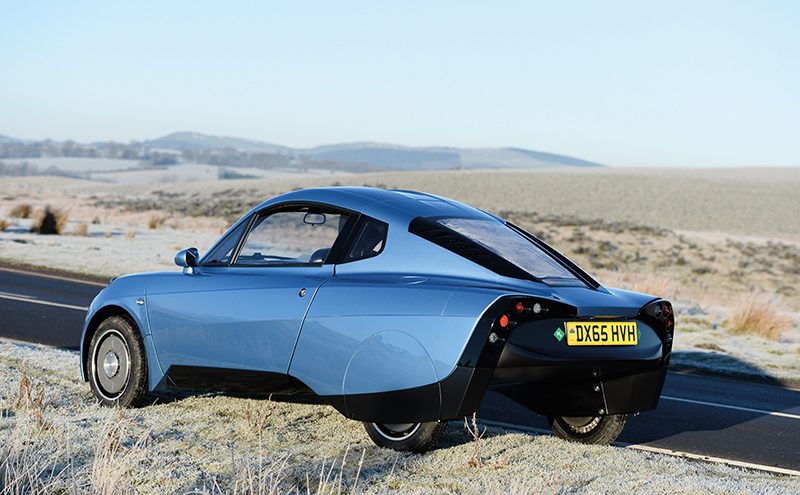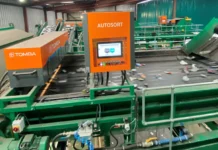NASA has been at it for years. It’s the imperative behind the phenomenal success of eBay. And it seems to be rising up the agenda of businesses and policymakers. But it requires unprecedented levels of cooperation between stakeholders. Paul Marsh visited the Scottish Resources Conference in September to hear about the latest milestones and challenges with the circular economy

One thing about the circular economy: It’s not easy. That much seems clear. Moving from a linear economy – where resources are fashioned into products without too much regard for the resulting waste – to one where everything is reused, repaired, reworked, or fed back into the production cycle in some way, involves an adjustment of the status quo that is hard to over-estimate.
Clever technology will help, and there’s been lots of that, as Nick Cliffe of Innovate UK related during an afternoon panel session, much of it seemingly in the area of materials science to enlarge the possibilities for recycling. An inspiring talk from Glasgow School of Art’s Irene McAra-McWilliam said aesthetics was an essential part of it, and hinted at the possibilities opened up when collaboration is productive. Behavioural and organisational change seems the most challenging part, and was the area to which the day’s discussion seemed to repeatedly return.
Understanding waste data
Michael Groves of Topolytics expressed the view that, “if the circular economy is going to be any kind of revolution, it will be a digital one”. We won’t get there, he suggested, until we get a better handle on what waste we’re producing and where it’s going. At the moment, it’s difficult to get a clear picture of commercial and industrial waste flows.
Currently, a large manufacturer might have a contract with a waste management firm, and any data about waste will be recorded by the latter, but it will only be crude, aggregated data. Topolytics is trying to get a more granular dataset from the manufacturers themselves, for whom there seems to be an appetite to better understand waste.
How can you use this data? This is where Topolytics cunning software appears to come in. The firm specialises in geospatial mapping and analytics – very fancy maps with lots of data analysis under the bonnet. Users of the software can get a handle on where different types of waste are being produced and transported. It means a biodiesel firm, for example, might be able to get a quick handle on the volumes of fats or oils being produced in a particular geographical area, which might lead to better location decisions.
One possibility – just an opinion of his own, he admitted – is that waste management will in the future progress to a more decentralised model. In much the same way as the energy sector has been moving towards a model of smaller, localised generation, so the waste industry might usefully evolve towards a network of smaller, more specialised recycling units located near the sources of waste.
But there’s a way to go, to reach the level of understanding implied by such a scenario. Even at a global level, said Groves, there is currently plenty of disagreement about what happens with waste. With e-waste, for example, Canadian geographer Josh Lepawsky has recently challenged the orthodox view that it simply flows from the developed to the developing world, from west to east. His work reveals a much more complex network of intra-regional flows, showing that Indonesia, for example, is a net exporter of e-waste. Lepawsky’s views are not widely accepted, however.
Lots more data is becoming available in the waste industry as with every other sector, and the question of doing something useful with it was also picked up by George Giles of Siemens UK in his talk looking at “digitalisation” (associated with buzzwords such as the Internet-of-things, Industry 4.0 and so on) and what it might mean for the circular economy.

The promise of digitalisation
He offered an example from his own work on energy-from-waste (EfW) plants. When his firm designs and builds these facilities it works closely with a digital or virtual model of the real thing. You can see how it all fits together – the turbine, the control area, and so forth – and pre-empt any engineering challenges at the design stage. You can even use it develop better ways of operating that plant once it is up and running.
Where digitalisation is taking us now, he said, is beyond just building an EfW plant, and into the realm of what might become possible when much more data is linked into a larger model of this kind. For example, data about where the feedstock comes from, or where the energy produced by the plant is consumed.
A big obstacle at this stage is cyber-security, which is making many firms wary of opening up their IT infrastructure in this way. But he seemed optimistic that digitalisation will open up all kinds of possibilities for closing loops and optimising resource usage.
Don’t overlook aesthetics
An obvious question is: how do we stop things from becoming waste in the first place? One answer is to make them “beautiful”, as Glasgow School of Art deputy director Irene McAra-McWilliam put it, remarking that this was a word we hadn’t heard so far in the day. “Function is not enough for most people,” she said. We have to take things that are normally merely functional and make them beautiful. If you go to the Museum of Scotland (in Edinburgh), for example, you can see objects that are hundreds, in some cases thousands, of years old. “People made all kind of simple things that were functional but they were also beautiful,” she said. “Which is why they’re in a museum for us to go and look at [them].”
There was a lesson there for circular economy advocates, she believed, and that was to do with linking the ethics of what we do – the domain of the day’s discussion, perhaps – with aesthetics.
For the GSA, the effort to make things beautiful seemed to involve an almost dizzying array of experts and artisans, specialists in all kinds of traditional crafts, bringing together disparate efforts in what she described as “extreme collaboration”.
Since the 2014 fire which destroyed the school’s Mackintosh library, a world-renowned art noveau masterpiece, concerted efforts have been underway to recreate the original down to every last detail; even using the same type of nails as the 1910 version. The effort has involved tracking down all “the artisans, all the craftsman, everyone who needs to make the thing beautiful, all over again”, she said.
Other projects showcased a similar blend of “hi-tech meets artisan craft”. For example, the Remantle project is repurposing old textiles, exploring the possibilities for closed-loop manufacturing in the fashion sector.
A project led by the school’s Highland campus brings together traditional craftspeople to work with lower-limb amputees to imbue a sense of personal identity to their prostheses, an accessory that is perhaps traditionally all too functional. CAD software is used to accurately render musculature alongside the structures and shapes of the intended prosthesis.
It’s all very well, she said, to talk about collaboration and inter-disciplinarity – seemingly indispensable qualities in the journey towards circularity – but how do you actually make it productive? How do you get an outcome? This was the question she said GSA has made its own, and to which these projects were presented as something of an answer.

Everyone gets a share?
Nick Cliffe of Innovate UK was just as emphatic on this point. In the manufacturing sector circularity has to enlist multiple actors throughout the supply chain, and it’s essential to ensure the benefits are shared. “Nothing will put a halt on your circular economy idea faster than creating a loser,” he said. “It doesn’t have to be equal, but everyone has to get a share.” The extreme lengths to which his group took this notion were apparent from the fact that the innovation competitions they administer in the circular economy area are inadmissible to single firms – entries are only accepted from collaborations.
His group aims to help innovators bring their ideas to market, and over a recent four-year period it had funded around 100 projects from 300 different firms to this end, to the tune of £20 million. This has included projects to look at things like replacing rare, difficult-to-process materials with substitutes, such as ones that are easier to recycle or more common. And projects to provide an outlet for recycled materials. “One of the main barriers that many producers of secondary raw materials find is that the market acceptance for their recycled product or material is not quite there.”
While the group no longer funds projects in the specific category of the circular economy, he said the principles underpinning these projects now imbue projects funded in every category, from automotive to health care – indicative of a general direction of travel.
Innovate UK has done a lot of work with firms looking to improve aluminium recycling, he said, including Jaguar, Ellis, and various small recyclers. One result is that more and more of the Jaguar XE’s bodywork is now made of aluminium, “which gives remarkable lightweighting, leading to much more energy efficient motoring”. This has involved a lot of material innovation, metallurgy and so on – the most recent iteration of this work has been with developing automatic sensing systems that can be used to allow the different grades of aluminium to be separated out from each other at an early stage in the recycling process.
Innovate UK gets lots of funding requests in the area of packaging, he said. A recent example was a real showcase of multi-actor collaboration, enlisting everyone from the ink maker to the company that makes the pouches to the big-brand retailer of the food product intended to go inside. By working together, he said, the project led to “some remarkable materials, packaging design and recycling technology innovation”.
This kind of co-operation can be fascinating for the secret pockets of expertise it seems to unlock, information that is normally quite silo-ed or hidden from view. It was remarkable, he said, to discover how much polymer manufacturers knew about how to make their plastics more compatible with recycled materials – a nod to the potential we can assume is being wasted by the existing disconnect between plastic manufacturers and plastic recyclers. We shouldn’t under-estimate the fruits to be reaped from breaking down some of these boundaries.
Prelude to a tricky conversation
All the same, moving to a circular way of doing business is in reality “surprisingly fraught with all sorts of challenges”, he said – including financial and regulatory ones.
He offered the example of Riversimple, a firm that has developed “an amazing hydrogen fuel cell electric vehicle”. The firm operates with a “servitisation” model – you buy mobility from them on a contract basis. “They’ve done amazing work on the design of the car, and on pioneering new fuel cell power trains”, he said. But the biggest challenge it faces is that its business model sees it realise the value of a car over a period of nearly 15 years. And this makes it hard to imagine approaching conversations with suppliers who operate on much shorter timescales. Just try asking the firm supplying windscreen wiper motors, who will likely work with invoicing terms of 30 days as standard, or 60 at a stretch, if they might consider stretching it to 15 years – Cliffe’s voice trailed off in comic self deprecation.
He saw this as the biggest barrier facing the circular agenda. “We may have made amazing strides with the technology”, he said. “Now it’s time to focus and innovate around the business model.”

The evil of obsolescence
One audience member asked how we could hope to persuade “global giant evil corporations like Apple” to stop building planned obsolescence into everything they make. “You need to move towards a structure where obsolescence is no longer the most economically viable way to deliver,” suggested Cliffe. It was tricky with firms like Apple which have an imperative to offer the latest and best technology. “But you can start to see a recognition that that particular direction of travel is slowing”. Apple, for one, is doing important work in areas like disassembly and recovery of materials – “some of the most advanced work I’ve seen, to be honest” – and so he said the economic case for this kind of thing appears to be growing.
Legislation also seems to be supporting a transition to a circular economy, such as the mandatory guidelines enforced with plastics recycling in the State of California.
McAra-McWilliam thought we needed to see a retro technology movement that would actually re-purpose old things in completely new ways – something very visible in India, she said. Companies would have to be encouraged not to make products completely obsolescent but to allow them to still be usable in limited ways.
The way we consume transport and accommodation is certainly changing very rapidly, as Cliffe noted, and it seems that all kinds of businesses are switching onto the fact that changing economic conditions mean there’s certainly less disposable income around than there has been for a while. “Most of these digital/servitised/circular ways of doing business are just cresting over the hype cycle”, he suggested, so it’s an exciting time to be working in this field and making it happen.







